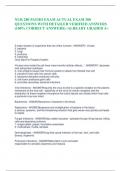NUR 280 PATHO EXAM ACTUAL EXAM 300
QUESTIONS WITH DETAILED VERIFIED ANSWERS
(100% CORRECT ANSWERS) /ALREADY GRADED A+
5 major classes of organisms that can infect humans - ANSWER1. viruses
2. bacteria
3. fungi
4. protozoa
5. helminths
(Very Bad For People's Health)
Viruses once inside the cell have many harmful cellular effects... - ANSWER1. decrease
host cell protein synthesis
2. viral antigens cause host immune system to attack the infected host cell
3. transform host cells into cancer cells
4. lysosome disruption produces cell lysis
5. cell fusion produces giant cells
6. promotes secondary bacterial infections
Viral Infections - ANSWERrequires the virus to bind to a specific receptor on the plasma
membrane of the host cell - specificity of the virus for certain receptors and the
distribution of these receptors throughout the host's tissues can dictate which host cells
a particular virus can infect
Bacteremia - ANSWERpresence of bacteria in the blood
Septicemia - ANSWERpresence and multiplication of bacteria in the blood
a serious, systemic, and life-threatening infection that gets worse very quickly and leads
to sepsis
Fungal Infections - ANSWERalso called mycoses - spreads through living tissues, killing
cells and absorbing nutrients
1. single-celled: yeasts, facultative anaerobes
2. multicellular: molds, aerobes
Dermatophytes - ANSWERfungi that cause infection of the hair, skin, and nails
(tineas, ringworm)
Protozoan Infections - ANSWERabundant in soil and water
responsible for amoebic dysentery and malaria
,Helminth Infections (Parasitic Worms) - ANSWERlive inside their host - typically cause
weakness and discomfort, but do not themselves kill the host, it is complications
resulting from parasitic infection that prove fatal - malnutrition, chronic bleeding, and
secondary infections by bacterial or viral pathogens
Adenoviruses - ANSWERchildhood respiratory infections, eye infections
Aspergillus fumigatus - ANSWERfungi - aspergillosis
Campylobacter jejuni - ANSWERmost common cause of bacterial diarrhea in US
Candida albicans - ANSWERfungi - thrush, vaginal yeast infections, systemic infections
Clostridium botulinum - ANSWERbacteria - food-borne botulism (food poisoning)
Clostridium tetani - ANSWERbacteria - tetanus
Enterococcus faecalis - ANSWERbacteria - wound infections
Epidermophyton, Trichophyton, Microsporum - ANSWER3 genera of fungi that cause
dermatophytoses (such as tinea capitis, tinea cruris, and tinea pedis)
Epstein-Barr - ANSWERvirus - infectious mononucleosis, Burkitt lymphoma
Escherichia coli - ANSWERbacteria - UTIs, neonatal meningitis, gastroenteritis, food
poisoning
Haemophilus influenzae - ANSWERbacteria - upper respiratory infection
Helicobacter pylori - ANSWERbacteria - most common chronic infection in humans,
gastric and peptic ulcers, acute infection causes abdominal pain, weight loss, nausea
and vominting
Hepatitis B virus - ANSWERhepatitis
Herpes simplex virus - ANSWERcold sores around mouth (HSV-1) or genital herpes
(HSV-2)
HIV-1 - ANSWERAIDS
Human papilloma virus - ANSWERgenital warts, cervical cancer
Influenza virus (A,B,C) - ANSWERinfluenza
,Kaposi's sarcoma-associated herpesvirus (KSHV or HHV-8) - ANSWERKaposi's
sarcoma
Klebsiella pneumoniae - ANSWERbacteria - lung infections
Measles - ANSWERvirus - measles
Mumps - ANSWERvirus - mumps
Mycobacterium tuberculosis - ANSWERbacteria - tuberculosis
Neisseria gonorrhoeae - ANSWERbacteria - gonorrhea
Neisseria meningitidis - ANSWERbacteria - meningococcal meningitis
Pneumocystis jiroveci - ANSWERfungi - pneumonia
Polio - ANSWERvirus - polio
Pseudomonas aeruginosa - ANSWERbacteria - skin infections, wound infections, burns
- epitome of an opportunistic infection pathogen of humans (CF and traumatic burns)
Respiratory Syncytial Virus - ANSWERmost common cause of bronchiolitis and
pneumonia in kids under 1 y/o
Rhinovirus - ANSWERcommon cold
Rubella virus - ANSWERGerman measles
Salmonella - ANSWERbacterial diarrhea, salmonellosis
Shigella - ANSWERbacteria - watery or bloody diarrhea
Staphylococcus aureus - ANSWERbacteria - skin infections, wound infections, burn
infections; almost anywhere in the body - MRSA
Staphylococcus epidermidis - ANSWERbacteria - otitis media, community acquired lung
infections and pneumonia, currently the leading cause of invasive bacterial disease in
children and the elderly
Group A streptococci (Streptococcus pyogenes) - ANSWERbacteria - respiratory
infections (strep throat, otitis pneumonia) and skin infections (impetigo, cellulitis) - 95%
of all strep throat cases in the US
Treponema pallidum - ANSWERbacteria - syphillis
, Trichomonas vaginalis - ANSWERbacteria - trichomoniasis (vaginitis)
Varicella-Zoster - ANSWERvirus - shingles and chicken pox
Two types of bacterial toxins - ANSWERendotoxin and exotoxin
Exotoxin - ANSWERproteins (primarily enzymes) or peptides made by the living
organism which damage the plasma membranes of host cells or prevent phagocytosis
- gram positive bacteria
- do not produce high fever
- antigenic (stimulate adaptive immune response)
- ex: Staphylococcus aureus, Vibrio cholera
Endotoxin - ANSWERpart of the bacterial cell wall that is released upon death of the cell
- gram negative bacteria
- activates inflammatory response and produces fever (pyrogenic response)
- does not elicit an adaptive immune response
- can result in endotoxic shock (septic shock)
- one cause of DIC
Mechanism of septic shock - ANSWER- host macrophages secrete tumor necrosis
factor-alpha (TNF-a is responsible for many of the manifestations of endotoxic shock)
- primary result is capillaries become 'leaky' and fluid is lost from circulatory system
- BP drops
- organ failure may occur, followed be death
- even if the host survives, the leaky blood-brain barrier may allow pathogens to cross
over into the CNS
Countermeasures against pathogens: vaccines vs. antimicrobials - ANSWERVaccines:
prevent the pathogen from initiating disease
- viral vaccines contain live viruses that have been attenuated so that the immunogens
are still expressed, but only capable of causing a limited-easily controlled infection
- bacterial vaccines consist of killed microorganisms or extracts of bacterial antigens
- vaccination against systemic toxins is achieved using toxoids (detoxified toxins)
Antimicrobials: destroys the pathogen once the disease process has started
- antibiotics kill or inhibit the growth of microorganisms by preventing the function of
enzymes or cellular structures that are unique to the infecting agents
- also includes synthetically formed compounds
- harder to develop antiviral antimicrobials because viruses use host-cell enzymes
First line of innate defense against pathogens - ANSWERsurface membrane barriers:
intact skin and intact mucous membranes, secretions of skin and mucous membranes
Second line of innate defense against pathogens - ANSWERinternal mechanisms:
PAINT (phagocytes, antimicrobial proteins, inflammation, NKC, temperature increase)




